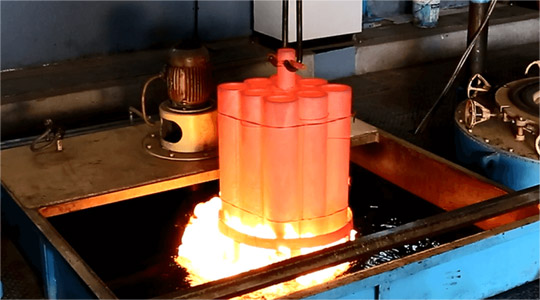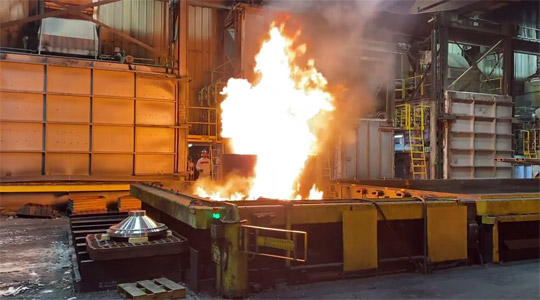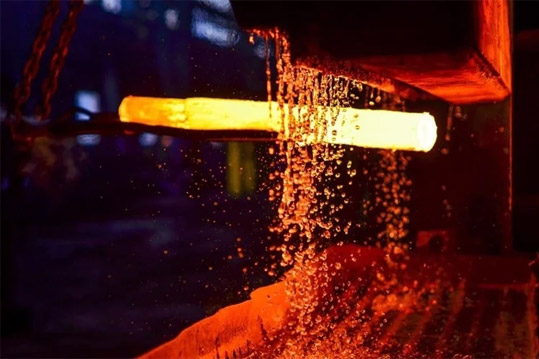Quenching is a heat treatment process that heating the workpiece to the appropriate temperature to increase the hardness and strength of the material. The purpose is to increase the mechanical properties, especially the hardness and wear resistance, by changing the internal organization of the metal. Quenching is often used in iron steel and other alloy materials.
Heating: Heat the workpiece to the corresponding quenching temperature, usually between 800 and 1000℃, depending on the type and composition of the material. For example, carbon steel is typically heated to 850-900℃, and alloy steel is heated to 950-1000℃.
Insulation: keep the workpiece at the quenching temperature for a period of time to ensure that the whole workpiece is heated evenly. The insulation time is related to the size, shape and material of the workpiece. It is usually calculated according to the thickness of the workpiece, and it is generally maintained for 1-3 minutes per millimeter.
Cooling: Rapid cooling is the core step of quenching. The choice of the cooling medium depends on the material of the workpiece and the final performance required. Common cooling media are water, oil, saline, and air. The faster the cooling speed, the higher the hardness and brittleness after quenching, and the slow cooling can avoid cracking or deformation.

preparatory phase:
Pre-cleaning of the workpiece: the workpiece should be thoroughly cleaned before quenching to remove oil and rust impurities on the surface, so as not to affect the heating uniformity and cooling effect.
Choose the appropriate heating equipment: the commonly used heating equipment for quenching includes gas furnace, resistance furnace and induction heater. For mass production, the induction heater can be used to heat up quickly; for large workpiece or high precision requirements, the resistance furnace is usually used for uniform heating.
Quenched operation:
Ensure uniform heating: workpieces should be heated as evenly as possible to avoid structural defects caused by local overheating or uneven temperature imbalance.
Control cooling speed: select cooling medium according to the requirements of materials and workpieces and adjust the cooling speed. For high alloy steel, oil cooling can be selected to reduce the cooling speed and reduce the risk of cracking, and for low carbon steel or simple shape workpiece, water cooling or air cooling can be used.
reprocessing:
Refire treatment: the workpiece after quenching has high hardness, but poor toughness, easy to crack. To eliminate the internal stress and adjust the hardness, the tempering treatment is usually required. The tempering temperature and time shall be controlled according to the use requirements of the piece, usually within the range of 150-650℃.

Selection of cooling medium: The selection of cooling medium directly affects the quenching effect. Water cooling is fast, but it is easy to cause cracking or deformation; oil cooling is milder, but it pollutes the environment; air cooling is slow, but it is suitable for high-alloy steel and complex-shaped workpieces.
Prevent overheating or overcooling: Heating temperature and holding time that are too long will cause grain coarsening and affect material toughness; too fast cooling speed may cause excessive internal stress and cause workpiece cracking. Therefore, the temperature and time during heating and cooling should be strictly controlled.
Prevent oxidation and decarburization: Oxidation and decarburization are prone to occur on the surface of the workpiece during quenching, resulting in a decrease in surface quality. Therefore, oxidation and decarburization can be reduced by filling the heating furnace with inert gas or heating with a protective atmosphere.
Influence of workpiece shape and size: Large or complex-shaped workpieces are prone to deformation and cracking during quenching. Therefore, it is necessary to consider the shape design of the workpiece before quenching, avoid stress concentration areas, or control deformation through slow cooling.
Operational safety: The quenching process involves high temperature and rapid cooling. Operators should be ensured to wear protective equipment to avoid splashing of high-temperature metal and cooling medium.

Quenching is an important process in the manufacturing industry to improve the hardness and strength of workpieces. By reasonably controlling the heating temperature, holding time and cooling rate, ideal material properties can be obtained. In specific operations, it is necessary to select appropriate cooling media and process parameters according to the properties of the material and the shape of the workpiece, and pay attention to preventing overheating, oxidation, deformation and cracking to ensure the quality and performance of the final product.